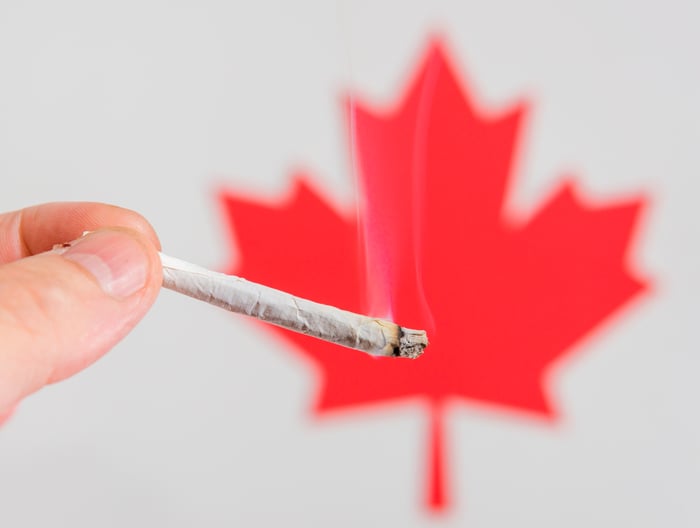| SPONSOR: Bougainville Ventures Inc (CSE: BOG) Converting irrigated farmland to greenhouse-equipped farmland. Bougainville does not “touch the plant†and only provides agricultural infrastructure as a landlord for licensed marijuana growers. Click here for more info. |

—————————————
Nearly 1 in 6 Canadians Have Used Marijuana Since Recreational Pot Was Legalized
New data from Statistics Canada offers an inside look at cannabis consumption rates based on province, gender, and age.
- The sky seems to be the limit for the legal marijuana industry.
- According to the most bullish forecast from Wall Street investment firm Cowen Group, the legal weed industry could surpass soda in global sales by 2030 and generate $75 billion in yearly revenue.
- More immediately, a co-authored report from Arcview Market Research and BDS Analytics has called for 38% global sales growth in 2019 to $16.9 billion.
Sean Williams Feb 23, 2019 at 10:51AM
The sky seems to be the limit for the legal marijuana industry. According to the most bullish forecast from Wall Street investment firm Cowen Group, the legal weed industry could surpass soda in global sales by 2030 and generate $75 billion in yearly revenue. More immediately, a co-authored report from Arcview Market Research and BDS Analytics has called for 38% global sales growth in 2019 to $16.9 billion. No matter how you analyze the data, that’s a lot of green to go around; and it’s a big reason why pot stocks have been virtually unstoppable since the year began.
Although the United States would represent the largest cannabis market in the world by sales if it were legalized at the federal level, it’s our northerly neighbor Canada that’s leading the charge on marijuana reform. Having become the first industrialized country in the world, and only second overall behind Uruguay, to legalize adult-use pot in October, Canada looks to be on track for an estimated $5.9 billion in annual sales by 2022.

Image source: Getty Images.
An inside look at the average Canadian cannabis user
But just how quickly are Canadians adapting to this legalized environment? For that answer, I turn to Statistics Canada, the national statistics office that gathers information on Canada’s economy, environment, and society.
Recently (as of Feb. 21, 2019), Statistics Canada released self-reported data on consumers’ use of cannabis over the past three months. As a refresher, marijuana legalization occurred roughly four months ago, although the first month was a supply-side disaster. That means the past three months of use should give us a really good idea of what the typical Canadian consumer looks like.
According to the data, which Statistics Canada will continue to update, 15.4% of all citizens, or nearly 1 out of 6 Canadians, have used cannabis over the past three months. As you can imagine, usage statistics tend to vary by region, gender, and age. For instance, Quebec had the lowest percentage of people using marijuana over the past three months (13.6%), while the lesser-populated Nova Scotia had the highest percentage by far at 21.6%. Newfoundland and Labrador and New Brunswick were also significantly above the national self-reported average in three-month use rates.
In terms of gender, men were significantly more likely than women (19.4% vs. 11.3%) to have consumed cannabis recently.
Finally, as you might expect, pot use over the past three months was considerably higher among younger people than older folks. Overall, 27.4% of Canadians aged 15 to 24 and 23.2% of those aged 25 to 34 used cannabis over the past three months. Meanwhile, just 5.2% of seniors aged 65 and up and 10.4% of Canadians aged 55 to 64 used weed recently. Even though the older generation has more disposable income, it’s these younger adults that are the future of the legal weed industry.

Image source: Getty Images.
Cannabis consumption rates are likely to rise — here’s why
Although there were no major surprises here, there are some relatively interesting takeaways to be made.
For example, an average use rate of just 15.4% might seem rather low, but it’s not factoring in two pretty important catalysts. First, there’s the fact that marijuana growers are still in the early stages of ramping up their production. Aurora Cannabis (NYSE:ACB), which is my selection to lead the country with 700,000 kilograms of peak annual production, is only producing at an annual run rate of 120,000 kilos right now. By the end of the current calendar quarter, Aurora Cannabis should be yielding more than 150,000 kilos annually, but it’s going to take perhaps 12 to 24 more months before Aurora is operating on all cylinders. When consumers have access to ample demand and the per-gram price for dried cannabis flower comes down a bit, we’re liable to see usage rates increase.
The second catalyst is the expected legalization of new consumption options by this fall. When the Cannabis Act was signed into law last June, and legal product sales commenced on Oct. 17, 2018, it only included dried flower, cannabis oil, and sprays. Alternative products such as edibles and cannabis-infused beverages aren’t yet legal. That, however, is expected to change by no later than Oct. 17, 2019, according to an outline presented by Health Canada. Edibles and infused beverages containing cannabidiol (CBD), the nonpsychoactive cannabinoid best known for its medical benefits, are expected to be especially important in luring in new users.
The provincial-use data is also interesting in that it highlights one potential under-the-radar grower: OrganiGram Holdings (NASDAQOTH:OGRMF). The New Brunswick-based OrganiGram is the only Atlantic grower expected to yield more than 100,000 kilograms per year when at full production capacity. Its geographic location gives it competitive advantages in New Brunswick, Nova Scotia, and Newfoundland and Labrador. Sure, these are far less populated regions than, say, Ontario or Quebec, but it nevertheless allows OrganiGram a foothold in these potentially higher-use provinces and territories. OrganiGram was already a value stock among its peers, but it’s now that much more intriguing following the release of this data.

Image source: Getty Images.
I believe this data also demonstrates the scope of opportunity awaiting Shopify (NYSE:SHOP) and its e-commerce platform. A number of large growers and provinces, including Ontario, have chosen to utilize Shopify’s sales platform for online and brick-and-mortar sales. Aside from simply being the sales platform of choice, Shopify offers marijuana companies purchasing data on consumers for pretty much the first time ever. With this being a cash-dominated industry, it’s been virtually impossible for growers and retailers to understand their customer base. With Shopify, this is going to change, and both producers and retailers will be able to more directly target consumers.
Ultimately, the legal weed industry is still in its infancy in Canada. That means we’re liable to see this data shift as Health Canada adjusts the boundaries of what’s legal and growers and retailers come to better understand their customers.
Source: https://www.fool.com/investing/2019/02/23/nearly-1-in-6-canadians-have-used-marijuana-since.aspx